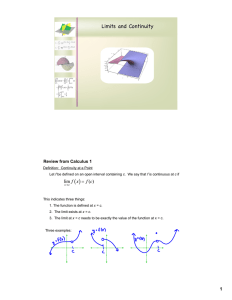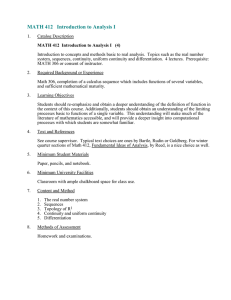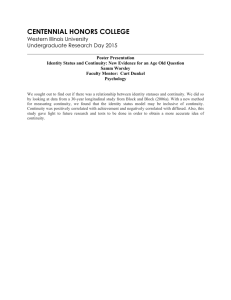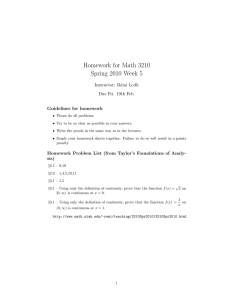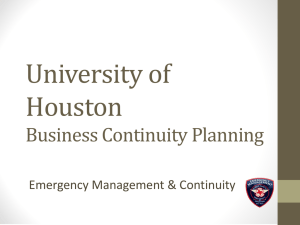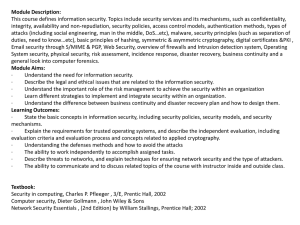Business Continuity Planning University of Houston Office of Emergency Management 4343 Elgin
advertisement
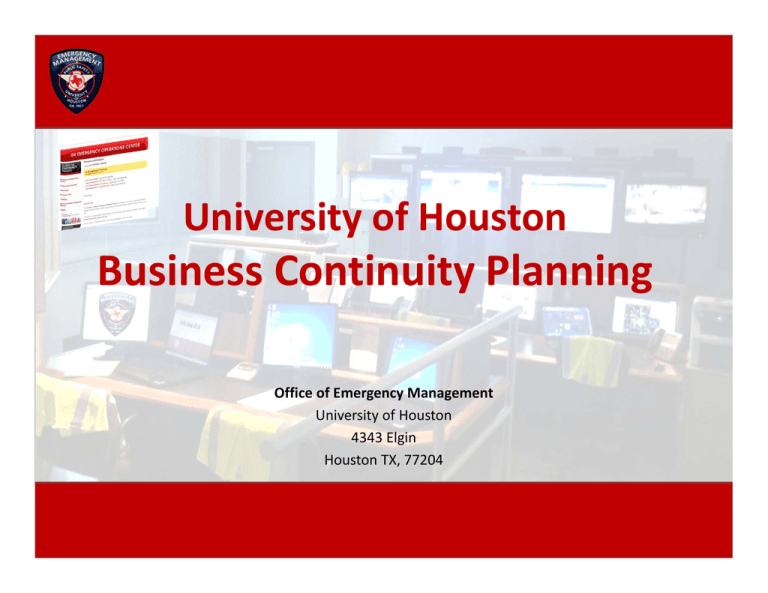
University of Houston Business Continuity Planning Office of Emergency Management University of Houston 4343 Elgin Houston TX, 77204 What is Emergency Management? The mission of the emergency management at the University of Houston is to: Prevent/Mitigate Prepare for Response to Recovery from, and Business Continuity Planning Business Continuity Planning (BCP): • Ensures compliance with Texas Administrative Code 202.74 Business Continuity Planning. • Ensures compliance with Texas Department of Public Safety – State Office of Risk Management Directive, Dated October 24, 2013 • Ensures compliance with Texas Labor Code, Title 5, Subtitle A, Chapter 412, Subchapter 1 – General Provisions • Assist in the mitigation effects of unexpected events which may disrupt normal business operations • Living document Business Continuity Planning University of Houston Business Continuity Planning: Business Impact Analysis Business Continuity Guide Business Continuity Template for Departments Purpose and Objective Purpose: • Improve readiness and response • Guide for departments to continue functions through any disruptive incident Objective: • Identify processes and improvements that would minimize or eliminate the amount of time and resources required to resume business Qualitative and Quantitative Why is Continuity Planning Important? $$$ Day 1…….Day 3…….Day5…………………….Day11…… Key Elements of Continuity Planning Business Impact Analysis Essential Functions & Plan Development Test & Exercise Implement & Maintain Identify 3P’s Use Priority Listing to Identify Essential Functions Develop Plan Implement the Plan Identify Critical Interruptions Address Individual Functions Training Maintain the Plan Assess the Impact & Prioritize Recovery Strategies Identify Gaps Annual Review People, Property and Processes Identify the resources/assets 3P’s (People, Places, Processes): People Property Students, Employees, Visitors, Vendors Infrastructure & Facilities Communications & Notifications Data & Vital Records Backup Assets, Equip & Supplies Availability Processes Business Cycles & Critical Dates ICT Systems & Single Point of Failure (SPOF) Operational Dependencies & Alternatives Elements of the Department BCP Elements: Objectives Contacts Data information/systems Emergency communication system Essential Function within the University of Houston Leadership succession Key internal/external dependencies Mitigation Strategy Exercise your plan Recovery Disaster recovery strategies Department Objectives Department Objectives: Consider your departments objectives and then list those objectives. Example: Teaching Research Operations Department Contacts Name Phone Number Campus Address Name Phone Number Campus Address Primary Contact Email address Dept. locations Secondary Contact Email address Dept. locations Data Information/Systems Data – Is computer data backed up regularly? – Is data accessible from an alternate location? – Is data accessible when the network is down? System – Are information systems essential during an emergency? • include details in your plan Department Emergency Communication Phone Email Text messaging Call tree UH web sites Pager Instant messaging Other (describe): Electronic Billboard UH radio station Department’s Function Instruction Student life support Laboratory research Research support Other research Facilities support Administration Other (describe): ________________________________ Essential Functions Essential Function: Primary Alternate Second Alternate Primary Alternate Second Alternate People Responsible Phone Numbers Essential Function: People Responsible Phone Numbers Leadership Succession Name Head of BCP First Successor Second Successor Third Successor Phone Number Alt Phone Number Key Internal/External Dependencies Internal Dependency (product or service): Provider (UH department): Dependency (product or service): Provider (UH department): External Dependency (product or service) Primary Supplier/Provider Phone Numbers Dependency (product or service) Alternate Mitigation Strategies Considering your departments objectives, essential functions and your internal/external dependencies, list steps your department can take to minimize risks. Payroll Example: Ensure all employees can utilize remote access Ensure processes can be completed remotely Ensure equipment can be relocated quickly Ensure all employees can work from home Exercising Your Plan Staff orientation meeting Emergency communication test Exercise Dates Call tree drill Offsite information access test Tabletop exercise Unscheduled work at home day Staff Distribution Date Interdepartmental exercise Emergency assembly drill X Other drill or exercise (describe): Recovery Describe how your department will begin the recovery processes and how the department will resume business operations as soon as possible after the crisis has passed. Identify and address: – resumption/scheduling of normal activities and services – work backlog – resupply of inventories – absenteeism – the use of earned time off – personal needs – any special consideration your department may need Special Considerations Describe special and unique considerations your department may face during an emergency. Example: – Health Center Pandemic Event • • • • • Health providers are healthy enough to provide care Facility can handle additional personnel/patients Arrangements have been made for additional facilities Back up locations are identified Know the Pandemic Plan Step 2: Identify Essential Functions and Plan Disaster Recovery Strategies: Condition Critical program space & facilities are damaged or not available Critical equipment is damaged or not available Centrally provided power becomes unavailable Communications via phone, fax, email, and internet becomes unavailable Central Information Systems are non‐functional. Mission critical data is not unavailable Local information systems (LAN or desktops) become non‐functional Staff is impacted by the disaster and not available to work Critical business partners or vendors are unable to provide goods or services Days 1 – 2 Days 3 – 4 Days 5 – 10 Days 11+ Comments Step 2: Identify Essential Functions and Plan Essential Functions (FEMA): A subset of government and other organizational functions that are determined to be critical activities used to identify supporting tasks and resources that must be included in the agency’s and organization’s continuity planning process. The overall objective of the continuity of operations plan, if possible, ensures a continuation of uninterrupted services during an emergency as well as and/or a rapid resumption of essential functions for the campus community. The Business Impact Analysis will assist in developing those essential functions for the organization. Step 4: Implement and Maintain the Plan Implement and Maintain the Plan: Implementation Plan Carry out the plan involves Communicate the plan Train the teams on the plan Approval pages on plan Maintenance Plan Set an annual review schedule Review, assess and document gaps from testing Update the plan Team assessment of the plan Continuity Planning Final Thoughts: • • • • Continuity plans are ever living documents Departmental Templates can assist with the process Work in Teams Recruit experts Be Prepared Resources • Business Continuity Resources From FEMA http://www.ready.gov/business/implementation/continuity • Business Ready.gov http://www.ready.gov/business • FEMA Emergency Management Guide for Business and Industry, A Step‐ by‐Step Approach to Emergency Planning, Response, and Recovery for Companies of All Sizes http://www.fema.gov/business/guide/toc.shtm • NFPA 1600 (National Fire Protection Agency) Standard on Disaster/Emergency Management and Business Continuity Programs http://www.nfpa.org/assets/files/pdf/nfpa1600.pdf • State Office of Risk Management ‐ BCP http://www.sorm.state.tx.us/risk‐management/business‐continuity‐ planning Questions? Be Prepared Make A Plan Be Informed Joe S. Méndez, M.P.A., M.S. Director, Emergency Management Email: jmendez3@central.uh.edu Office: 832‐842‐5503 Kelly Boysen, B.S., M.A.G. Emergency Management Specialist E‐mail: krboysen@uh.edu Office: 713‐743‐2841 Ginger Walker, B.A. Emergency Management Specialist Planning and Business Continuity E‐mail: gkwalker@uh.edu Office: 832‐842‐0583 www.uh.edu/emergency

